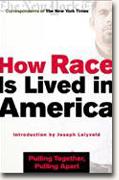How Race is Lived in America
Correspondents of the NYT
book reviews:
· general fiction
· chick lit/romance
· sci-fi/fantasy
· graphic novels
· nonfiction
· audio books
· author interviews
· children's books @
curledupkids.com
· DVD reviews @
curledupdvd.com
newsletter
win books
buy online
links
home
for authors
& publishers
for reviewers

 |
How Race is Lived in America
Correspondents of the New York Times edited by Joseph Lelyveld Henry Holt Hardcover April 2001 394 pages  |
|
Especially poignant are stories about white middle-class male children identifying with and literally buying into black "hip-hop" culture; a sober tale of a young lower-class boy of mixed heritage (white, black, Cherokee) with a black father, a white mother, and two older male white siblings who endures intra-family abuse, abandonment, discrimination and forced segregation within and outside the family unit; and a news-driven story about an upper-middle class nineteen-year-old blonde, white, male football star who is recruited by predominantly black Southern University and a black coach in his home town of Baton Rouge, Louisiana to play quarterback. Guess what happens? Indeed, eleven of the fifteen chapters deal primarily with white, black and other male burdens and struggles while only two stories deal primarily with interracial female experiences of growing up in a divided, culturally-diverse society. Ironically, but not unexpectedly, the book concludes with as much confusion, disagreement, and lack of consensus regarding "race" as was anticipated for such a complex, controversial topic in the first place. More introspection, self-disclosure, experience, and insightful comments by contributing reporters and editors appear in "Part II: The Conversations." The appendix provides telephone survey results of polls on race taken over the last ten years which are rife with seeming contradictions, yet provide tantalizing numerical signs of possible improvement and areas needing improvement in race relations. This reader started to wonder if the earlier poll results had informed or been used in any way by the investigative reporters who contributed the original 1999 articles and stories for this book? This book is not filled with sensational stories, that is, scandals, murders, sex and mayhem; nor does it give equal coverage to all minorities, cults, extremist groups (e.g., "skinheads") or special interests; nor does it argue for simplistic solutions or persuasive resolutions to issues of race. The book is a serious read which asks sobering, at times implicit, questions about ourselves, our identities, prejudices, interpersonal and public treatment of fellow members of our neighborhoods, communities, states, and nation -- questions most of us can not answer fully with one hundred percent certitude and veracity. Questions without which we have little focus and few comparative guidelines to monitor collective efforts to extend contacts, insure equal protections and understand meaningful communications with persons sharing with us their lives, responsibilities, labor, goods, services and status honors as well as the burdens of race, poverty, discrimination, leadership and diversity in a dynamic, changing society. © 2001 by David L. Johnson, PhD for Curled Up With a Good Book |
 Click here to learn more about this month's sponsor! |
|
| fiction · sf/f · comic books · nonfiction · audio newsletter · free book contest · buy books online review index · links · · authors & publishers reviewers |
|
| site by ELBO Computing Resources, Inc. | |
 Stories of compromise and accommodation flow from an Assembly of God church membership in Georgia; "black" and "white" Cuban Americans now living in Miami, Florida; and the daily ups and downs of interaction between black and white, Jewish, male writers working with
a combative black male director on the HBO series, "The Corner." One of the few female
intergenerational stories centers around an older white female plantation owner with a colonial view in conflict with a much younger black female U.S. Park Service employee's desire to preserve a history of slavery for today's public. Other chapters deal with the perceived divergent impact of race on corporate investments, male entrepreneurial vocational careers and political campaigns. Other stories focus on interracial marriages, parenting, schooling, work, SES, family, community and cross-cultural/sub-cultural relationships. One story highlights the covert, manipulative aspects of "racism" by detailing misperceptions, derogatory labels and competition for promotions between black and white male noncoms occupying the same status position
(e.g., Staff Sergeant) in the Army at Fort Knox, Kentucky. A contrasting story illustrates the overt, blatant hostility, hopelessness, fear and disgust which emerges from an informal "pecking-order" of positions, inequitable pay, disrespect and discriminatory treatment which is easily exploited by white management seeking greater profits in deplorable segregated work-site conditions in a meat-packing plant in North Carolina.
Stories of compromise and accommodation flow from an Assembly of God church membership in Georgia; "black" and "white" Cuban Americans now living in Miami, Florida; and the daily ups and downs of interaction between black and white, Jewish, male writers working with
a combative black male director on the HBO series, "The Corner." One of the few female
intergenerational stories centers around an older white female plantation owner with a colonial view in conflict with a much younger black female U.S. Park Service employee's desire to preserve a history of slavery for today's public. Other chapters deal with the perceived divergent impact of race on corporate investments, male entrepreneurial vocational careers and political campaigns. Other stories focus on interracial marriages, parenting, schooling, work, SES, family, community and cross-cultural/sub-cultural relationships. One story highlights the covert, manipulative aspects of "racism" by detailing misperceptions, derogatory labels and competition for promotions between black and white male noncoms occupying the same status position
(e.g., Staff Sergeant) in the Army at Fort Knox, Kentucky. A contrasting story illustrates the overt, blatant hostility, hopelessness, fear and disgust which emerges from an informal "pecking-order" of positions, inequitable pay, disrespect and discriminatory treatment which is easily exploited by white management seeking greater profits in deplorable segregated work-site conditions in a meat-packing plant in North Carolina.